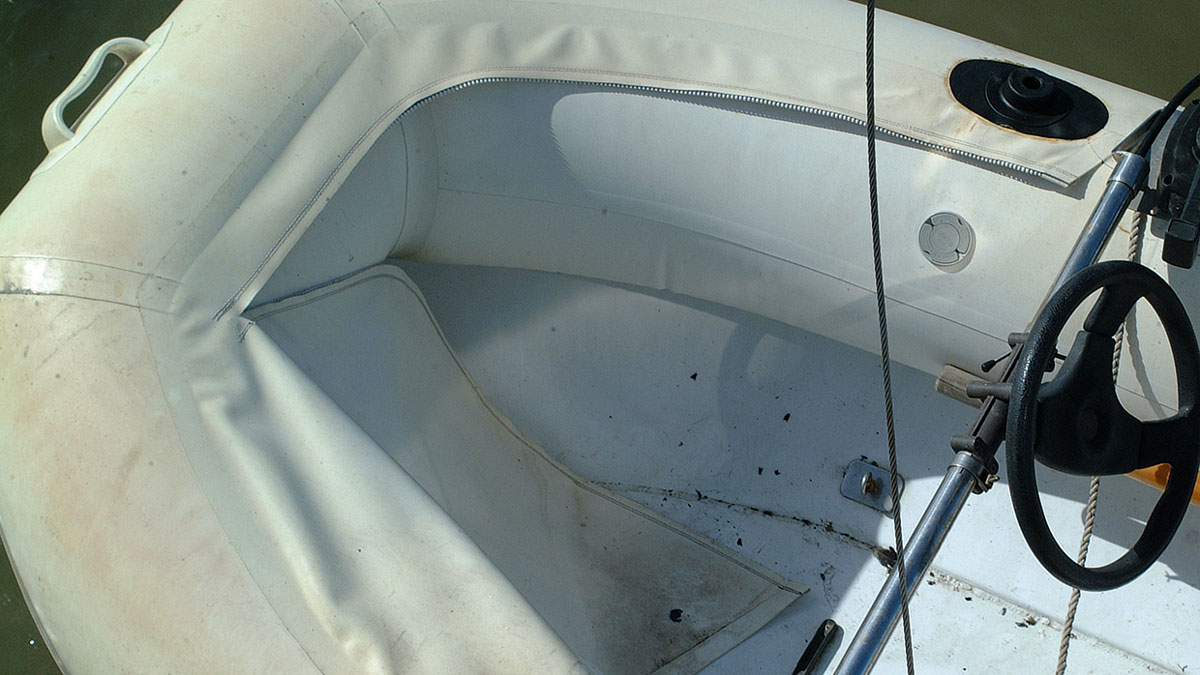David Parker describes the process involved in replacing the old rubber seals on his boat's port lights
When I bought my boat, I inherited some rather messy-looking port lights where old sealant compound had been used in an attempt to prevent leaks around the seals.
The excess had dried into unsightly dribbles and lumps, but I was cautious about removing this in case I disturbed the bond and introduced old leaks again.
However, the decision was made for me after one particularly choppy passage when both port and starboard port lights got a right dousing, and over time both let in quite a bit of water.
It was time for the old rubber port light seals to be replaced, and here’s how I did it.
Replacing port light seals: step-by-step

Credit: David Parker
1. At the top of the frame, locate which side of the pivot pin has a serrated end: this is the side which should come out first

Credit: David Parker
2 Use a small drift to tap out the pin. In this case, I used a cut-down nail which fitted the inside diameter of the locking hole

Credit: David Parker
3. Here the pin can be seen almost fully removed, but do not use excess force in case you crack the frame

Credit: David Parker
4. When the opening part of the portlight has been removed, clean the frame rim to provide a smooth surface for the new seal

Credit: David Parker
5. Carefully remove the old seal. I used the narrow blade of a craft knife to get underneath it to hook it out.

Credit: David Parker
6. You can see the salt deposits on the old ring and where the rubber has developed hard spots, but try not to damage it until you are sure that the new seal fits.

Credit: David Parker
7. Clean out the old sealant and thoroughly remove any grime from the frame with a suitable solvent. I used isopropanol.

Credit: David Parker
8. Put a bead of adhesive sealant in the recess to hold the new ring in place. Don’t use too much, otherwise, when you screw the port light tight it will all squeeze out again.

Credit: David Parker
9. Carefully fit the new seal so that it sits evenly in the rim and bed it down into position, holding it with gentle pressure for a couple of minutes.

Credit: David Parker
10. Remove any excess adhesive with a clean rag and solvent; with this particular sealant, Goop, I used white spirit.

Credit: David Parker
11. Put some Vaseline around the internal frame edge to prevent any excess sealant bonding to it when you screw the port light tightly shut.

Credit: David Parker
12. Refit the opening part when the sealant has partially cured. With Goop, this takes between 2 and 10 minutes

Credit: David Parker
13. With the port light open, lightly tap the pivot pin back in place until the end of the pin is flush with the frame

Credit: David Parker
14. The new seal is now fitted. However, the material takes 24 hours to cure, so only lightly clamp shut the seals for this period.
Pivot pin tip

Credit: David Parker
Pivot pins may vary slightly for each port light frame, so keep them with the same sealing ring for refitting.
If they are damaged or worn, they should be replaced.
A versatile marine sealant

Goop worked perfectly for replacing the rubber port light seals. Credit: David Parker
Goop – or to give it its full-on American name, ‘Amazing Goop’ – is a marine adhesive which quite a few boat owners haven’t heard of, it would seem.
Perhaps this isn’t all that surprising because not all chandlers stock it, although it has been around quite a long time.
It is a very versatile, flexible adhesive which dries clear and can repair and seal a wide variety of materials.
As well as using it as a general sealant on board I’ve also used it to make repairs to my diving mask and dry suit. It can also be used on glass, wood, metal, leather, vinyl, rubber and other materials.
What I find particularly handy about it is that it comes both in a cartridge and a tube.
Having it in a tube is especially useful because it can be used and reused in small amounts.
Often the problem with sealants and caulking compounds which are only available in a cartridge is that once they are opened they dry out too quickly or go hard before the cartridge is finished, even if kept in the fridge.
This is both expensive and wasteful.
The Goop in the tube, however, seals with a simple screw cap and I’ve had no problems with it curing in the nozzle.
Replacing crazed boat portlights
Stu Davies saves a bundle by having new acrylic windows made
How to install boat portholes
Phil Taylor reduces the size of the windows on his Sabre 27 by fitting portholes for offshore sailing
How to repair a heavy-duty zip on a bow dodger
Tony Davies demonstrates how you can restore a broken heavy-duty zip to full working condition
How to apply KiwiGrip to your deck
Ben Meakins used KiwiGrip deck paint to refresh the non-slip on his boat’s decks last winter – but how well…
Want to read more practical articles like How to fit new rubber port light seals?

A subscription to Practical Boat Owner magazine costs around 40% less than the cover price.
Print and digital editions are available through Magazines Direct – where you can also find the latest deals.
PBO is packed with information to help you get the most from boat ownership – whether sail or power.
-
-
-
- Take your DIY skills to the next level with trusted advice on boat maintenance and repairs
- Impartial in-depth gear reviews
- Practical cruising tips for making the most of your time afloat
-
-
Follow us on Facebook, Instagram, TikTok and Twitter







